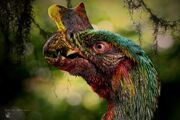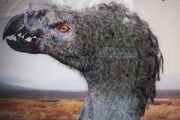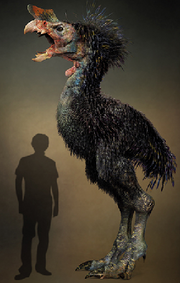Tag: sourceedit |
Tags: Visual edit apiedit |
||
| Line 26: | Line 26: | ||
[[File:Tyrannornis_imperator.png|thumb|Size of ''Tyrannornis imperator'' compared to humans: ''Tyrannornis imperator'', an aggressive haunting arid savannahs and steppes. ''Tyrannornis imperator'' is the king of communication. It's able to be heard in dozens of kilometers away! His cry is the hyoïd bone very developed in this bird.]] |
[[File:Tyrannornis_imperator.png|thumb|Size of ''Tyrannornis imperator'' compared to humans: ''Tyrannornis imperator'', an aggressive haunting arid savannahs and steppes. ''Tyrannornis imperator'' is the king of communication. It's able to be heard in dozens of kilometers away! His cry is the hyoïd bone very developed in this bird.]] |
||
| − | + | The ''Tyrannornis'' is really funny to "volatile". It illustrates the enormous evolutionary potential that could have birds from Néozoique, especially with the emergence of new land bird species. Indeed, we believe that the large continental mammals of our time: elephants, giraffes, bears, wolves ... |
|
In the early 21st century are already on the brink. This tragic death could free many ecological niches and thus contribute to the radiation of new land birds. |
In the early 21st century are already on the brink. This tragic death could free many ecological niches and thus contribute to the radiation of new land birds. |
||
Revision as of 12:12, 28 August 2016

The male Tyrannornis. Who would worry such a superpredator? There is smaller bird species that is an egg-eater which does not attack adults, but their offspring instead, called the Neoviraptor. Thus, thanks to this egg-stealer, the Tyrannornis populations are regulated.
Systematic: "Aves" (Bird), Psittaciformes (speakers of tropical birds Group), the parrot family (parrots group, parakeets, ect.)

Female Tyrannornis Rex. Slenderer than the male, presenting more neutral colors. Although less eye-catching, she remains as aggressive and territorial as him.
Etymology: From "Tyranno" the tyrant "Ornis" the bird in Greek. The species name "Rex" means "king".
Cousin of the XXI century: Psittacus erithacus, the African gray parrot of Africa.
Height: 3 meters for males and 2.50 meters for females.
Distribution: The species lives in Eurafrique, haunting the tropical forests and mangroves.
Morphology: This giant parrot has no wings. Its hind legs are well developed and equipped with sharp claws. His horny beak has pseudo-sharp, tooth-like structures like razorblades. These appear due to reactivation of dinosaurian ancestral genes. The thumb, which allowed their distant cousins to maintain current branches, has regressed so that it forms a catch. Sexual dimorphism is marked.
Ethology: The brain of the T-rex of the future is very developed, as with any other parrot. The brain areas of communication and cognition are more important, what makes Tyrannornis a very intelligent and social bird. Intraspecific communication is indeed based on a complex spoken language using infrasonic sounds. Unlike its cousins, generally eaters of fruit, Tyrannornis rex is a purely carnivorous predator who hunts of large prey, like Hadrornis and Giraffornis, in groups. This change in diet is a form of adaptation that is equivalent to that of the panda, a carnivore that became a mostly herbivorous omnivore.

Female Tyrannornis rex outgoing mangroves.
Populations are grouped into "clans" in the form and size of the ridge, which shield office. During drought periods, there are some clans declaring war: the ritual is orchestrated on both sides by an old chief who sends young males in to fight. The battles are bloody. They stop when the first male is killed.
Reproduction: The female lays 3-6 eggs in a nest every year. She makes it by digging in the ground and, after laying her eggs, covers it with plant debris. She protects her brood fiercely, and she teaches them how to survive after they have hatched until they reach maturity. The growth of chicks is two times faster than the current ostriches. The "T-rex of the future" has no wings but sometimes even some chicks are born with stubs of sorts: these stubs are then systematically devoured by the mother.
Diversity of Tyrannornis

Size of Tyrannornis imperator compared to humans: Tyrannornis imperator, an aggressive haunting arid savannahs and steppes. Tyrannornis imperator is the king of communication. It's able to be heard in dozens of kilometers away! His cry is the hyoïd bone very developed in this bird.
The Tyrannornis is really funny to "volatile". It illustrates the enormous evolutionary potential that could have birds from Néozoique, especially with the emergence of new land bird species. Indeed, we believe that the large continental mammals of our time: elephants, giraffes, bears, wolves ... In the early 21st century are already on the brink. This tragic death could free many ecological niches and thus contribute to the radiation of new land birds.

Tyrannornis lehoucqi is desertic species, has particularly developed auditory abilities allowing him to hunt at night.
Because we believe the birds have beautiful days in front of them. Tyrannornis, cosmopolitan, reign on various habitats.When connecting this "T-rex" to the future of present species and invent an evolutionary history, we have "rooted" in the parrot group. We hope so, break the stereotype of making the volatile docile parrots, excellent imitators can serve as pets.
Who says that tomorrow these highly intelligent birds will not be terrible predators? The beak of current parrots is a fabulous tool: powerful, it breaks nuts or allows such a third member, to climb trees ... Following the reactivation of certain genes dinosaurs that lie dormant in birds (geneticists 21st century are able to "redo" grow teeth-in fact pseudo-dents- in chick embryos), the toothed beak is a Tyrannornis weapon of mass destruction.
Delected Tyrannornis: Tyrannornis boisei

Tyrannornis boisei
He was seen for the first time on youtube the side of Tyrannornis rex (when the latter was appointed Diatrymamimus boisei (herbivorous terrestrial bird that was mistakenly considered a predator). It is unclear why it was not in the book but what is certain is that this is the largest member of the family Tyrannornis: it is a carnivorous bird which is 4 meters high and has a cranial crest crescent moon and a beak edged.
